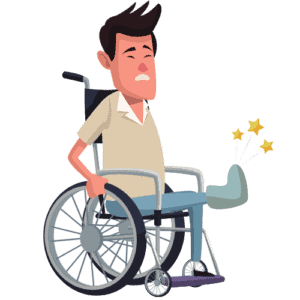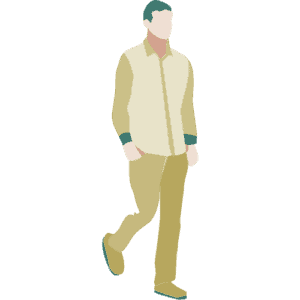LEARNING TO WALK…AGAIN
 Have you had the unfortunate experience of breaking a leg or a hip and then having to learn to walk again? Or perhaps you have been hospitalized for an extended period and discovered just how debilitating bedrest can be?
Have you had the unfortunate experience of breaking a leg or a hip and then having to learn to walk again? Or perhaps you have been hospitalized for an extended period and discovered just how debilitating bedrest can be?
If we live long enough, we may reach a point where our bodies become frail and a bit unbalanced. As an everyday activity, walking becomes the center of our thoughts with visions of staggering, stumbling, or, heaven forbid, falling.
Did you know that the most common risk factor for falling is the FEAR of falling? Well, that makes sense! Statistically, every 11 seconds an older adult is treated in the emergency room for a fall! The fear of losing our mobility is intimately tied to this fear of falling.
WHAT WE FEAR THE MOST
 What is it we fear the most besides the embarrassment of a belly smacker in front of others?
What is it we fear the most besides the embarrassment of a belly smacker in front of others?
I don’t know about you, but I want to go wherever I want, whenever I want. Yes, I know I should have outgrown that by now, but to walk in the woods or attend a BBQ on uneven ground on my grandchildren’s birthdays are high on my list of freedoms.
I also fear that the less I move, the more weight I will gain, which is depressing. The idea of giving up a home that I have lived in for a lifetime is heartbreaking. Not to mention the complications of a bad fall, the most serious of which is death!
No, I don’t want to lose my mobility! I am passionate about moving around in my world, regardless of whether it is on my own two feet, using walking aids, or even a wheelchair. Getting from point A to point B is my goal. Sitting in one spot is not. Nor is falling.
WHY IS THERE SO MUCH SHAME ACCOMPANYING
A LOSS OF MOBILITY?
It is bad enough to incur all the limitations mentioned above. Still, I have observed something equally if not more debilitating in the lives of many people as they age. SHAME.
 There is a stigma to publicly using a walker or wheelchair to get down the street. Images of aged demented forgotten souls relegated to isolation in nursing homes haunt most of our imaginations.
There is a stigma to publicly using a walker or wheelchair to get down the street. Images of aged demented forgotten souls relegated to isolation in nursing homes haunt most of our imaginations.
There was a time not so long ago (or maybe it was because I was still a kid) that wearing eyeglasses was a sign of disability and called forth nicknames like ‘four-eyes’ to the unfortunate child who couldn’t see the blackboard.
Today, glasses are a fashion statement, and many people have several pairs to wear with different outfits.
I look forward to the day when mobility devices have the same reputation. It will be a beautiful day when shame is replaced by pride in the coolest, most colorful classy cane or walker in the neighborhood. I believe in ‘classy’ for safety in walking. See “How to Accept an Assistive Device” for an example of a classy walking aid.
APPROACHES FOR LEARNING TO WALK AGAIN
Although Physical Therapy is one good approach to getting back on our feet after losing mobility from any number of causes, I would like to share how both mindful walking and a change in mindset helped me to leave a wheelchair and continue life on my feet.
I was in my mid-twenties when I was diagnosed with MS. Walking became akin to a circus act on the high wire. I won’t bore you with all the details here, but only say I have had to learn to walk. Again. And again. And again. Several times over the last fifty years. MS, for some people, is an on-again-off-again experience that may not always be visible but impacts mobility in many unpredictable ways.
The most critical factor that helped me regain stability was not the skill of the therapist, though their help certainly shortened my journey. Nor is it faith in miracles, though prayer is a big part of my life. But I believe the most essential piece of rehabilitation for regaining lost ground in any area of life is a mindset of positivity, together with a heart surrendered to reality…the reality that everything changes.

As an optimist, I have always had an “I can” attitude, but I would be lying to say I didn’t go through some long seasons of discouragement.
Knowing that a positive mindset changes body chemistry as inevitably as medication, I set out to change mine.
I needed to do a lot of inner spiritual work to reach a place of ‘equanimity’, or steadiness of soul, to withstand the doubts and fears that nothing is ever going to change. I am thankful for some good spiritual teachers and psychotherapists along the way.
We can do all the right things, however, and our feet may continue to drag and a wheelchair is the smartest thing to use. I am grateful for the wheels that have kept me going in life!
ANOTHER APPROACH

The second practice I employed is that of mindfulness—specifically, mindful walking. If you ever get a chance to take a course in MBSR (mindfulness-based stress reduction), don’t hesitate!
One of the practices of mindfulness, as taught by Thich Nhat Hahn, is mindful walking. Here is a 2-minute video on how to walk mindfully.
When I had to retire because of MS, I moved to an old mobile home. I used a wheelchair and/or a walker at the time and had just completed a month of rehab at a prestigious Boston rehab center.
At that time, my goal was not to go hiking but to be able to access life and everything that made life vital to me.
HOPE IN THE SHADOWS
 When I left the Rehab hospital in Boston I found myself home, alone, and clinging to a walker, wondering how I would stand, walk, or even run again.
When I left the Rehab hospital in Boston I found myself home, alone, and clinging to a walker, wondering how I would stand, walk, or even run again.
I sat in my chair and stared at a religious icon on the opposite wall for hours every day.
One day as I repeated the 23rd psalm, almost as a mantra, I had a flash of insight. “Though I walk through the shadows…” Wait a minute! You can’t have shadows without light!
That one moment was a turning point in my journey back to life. It’s the moment I began looking for the light.
I realized I had a 30 foot stretch down the center of my home, and so I began mindful walking. In the process of slow, measured steps, concentrating on each micro-movement in my legs and feet, I started one of the longest hikes in my life.
Back and forth, thirty feet. Sixty feet. 90 feet. Day after day. That was 12 years ago. Today I walk mostly unassisted. It has been nearly 50 years since I gripped my first walker, (whose name was Mehitable Hazard, but that’s another story). And my wheelchair (named Hell-on Wheels) has a nice place to sit…in the garage.
I am grateful for these alternative ways to get from A to B. That is my ultimate goal, after all. And I am grateful for the practice of mindfulness as one of the tools that helped me to do that on my feet.
I hope sharing my story has given you the courage to look for the light in your darkness, and some ideas of how to keep walking or moving despite the shadows.


Ellen Sweeney
This post really struck a chord. As you described your challenges my family is going through some similar changes in our life. A family member has fallen a few times and it’s been devastating for her. Reading your post will hopefully give her some hope. Thanks for sharing your resources as well.
Ardis Mayo
You are welcome. Changes in mobility are devastating life changes as you point out. Because they slow us down they also bring deeper reflections about things we don’t like to think about…and that can be scarier than not walking. Praying for insight and patience for your family member. And something very classy to help with stability.
Janet T
This also struck a chord with me. I’ve fallen and broken an ankle. Learning to walk again was a lesson in courage. My fear of falling took on PTSD qualities. Impending doom stalked me. But I did learn to walk again, and with time I could walk by offending curbs without my heart racing. The more often I walked past, the more I could gather the evidence that I’m not being threatened after all. I’m now struggling with another problem where I worry that this will never change, and it’s the same sort of issue. Courage. Trying. Reminding myself of success in other times. Not giving in to that inner voice of doom. You’ve really given me some good thoughts to ponder. Thanks.
Ardis Mayo
You are welcome. I know for myself, I regained my courage by embracing classy assistive devices and just walking. These things helped me with my fear of falling, and I continued to keep my eye on getting stronger…and braver. YOu may want to read my post https://thereflectivepen.com/assistive-device/ for a look at what I use these days to keep my walking skills and strength up without fear.
Judith Scarborough
Thank you for sharing your brave story and insights on learning how to walk again. The 2 minute video gave some good tips on how to walk mindfully, and I will practice those. Blessings on you!
Ardis Mayo
Thank you. And may you receive blessings with each mindful step you take.
Terrie Mourningdove
Every word is so meaningful, relatable and precious to me right now as a cane is my constant companion when I leave my apt. You are my Hero Ardis.
Ardis Mayo
Oh please tell me your cane has flowers or polka dots or something personally meaningful. Keep it classy!
Bonnie Keast
Another fine one, Ardis. And provided a welcome reminder to walk mindfully rather than in the mind as I walk.
Ardis Mayo
I like the way you put that. Often I realize I walk ‘in my mind’.